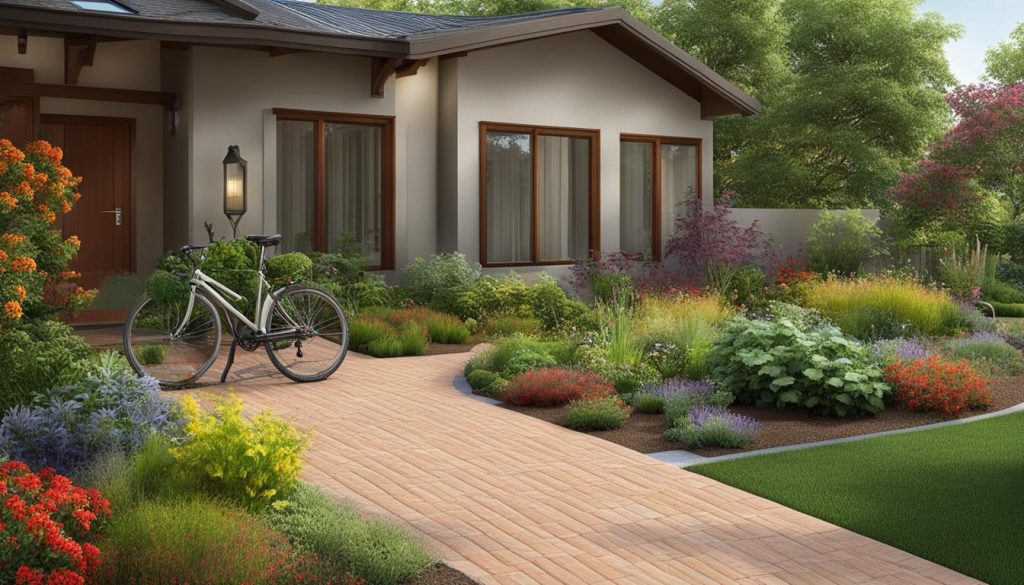Welcome to our guide on sustainable landscaping and eco-friendly choices. In this article, we will explore how sustainable landscaping can make a positive impact on the environment and contribute to a greener future for us all. By making eco-friendly choices in our outdoor spaces, we can create beautiful and sustainable landscapes that benefit both us and the planet. Join us on this journey towards a more sustainable way of living.
Key Takeaways
- Sustainable landscaping can contribute to a more eco-friendly and sustainable way of living.
- Making eco-friendly choices in your outdoor space can positively impact the environment.
- Using native plants, rainwater harvesting, and other key elements can make your landscape more sustainable.
- Designing a sustainable landscape involves utilizing eco-friendly features and materials.
- Maintaining a sustainable landscape requires responsible pest management, efficient irrigation, and the use of organic fertilizers.
Why Choose Sustainable Landscaping?
When it comes to landscaping our outdoor spaces, traditional practices often rely on chemicals and heavy water usage, which can have significant environmental impacts. Choosing sustainable landscaping practices, on the other hand, can provide numerous benefits for the environment, as well as for our own wellbeing.
Eco-Friendly Practices
Sustainable landscaping involves using practices that are environmentally friendly and resource-efficient. This includes using native plants, which are adapted to the local climate, require less water, and support local ecosystems. In contrast, traditional landscaping often uses non-native plants, which can require excessive water, fertilizers, and pesticides to keep them healthy.
Other eco-friendly practices that can be incorporated into sustainable landscaping include:
- Composting to reduce waste and improve soil health
- Using organic fertilizers to avoid harmful chemicals
- Implementing efficient irrigation systems to conserve water
- Creating wildlife habitats to support biodiversity
- Using permeable paving to reduce water runoff and erosion
Environmental Impact
Traditional landscaping practices can have numerous negative environmental impacts, including:
- Excessive water usage
- Contamination of soil and water from chemical fertilizers and pesticides
- Greenhouse gas emissions from lawn mowers and other equipment
- Loss of biodiversity from non-native species and habitat destruction
On the other hand, sustainable landscaping practices can help mitigate some of these impacts by reducing water usage, avoiding harmful chemicals, and promoting biodiversity.
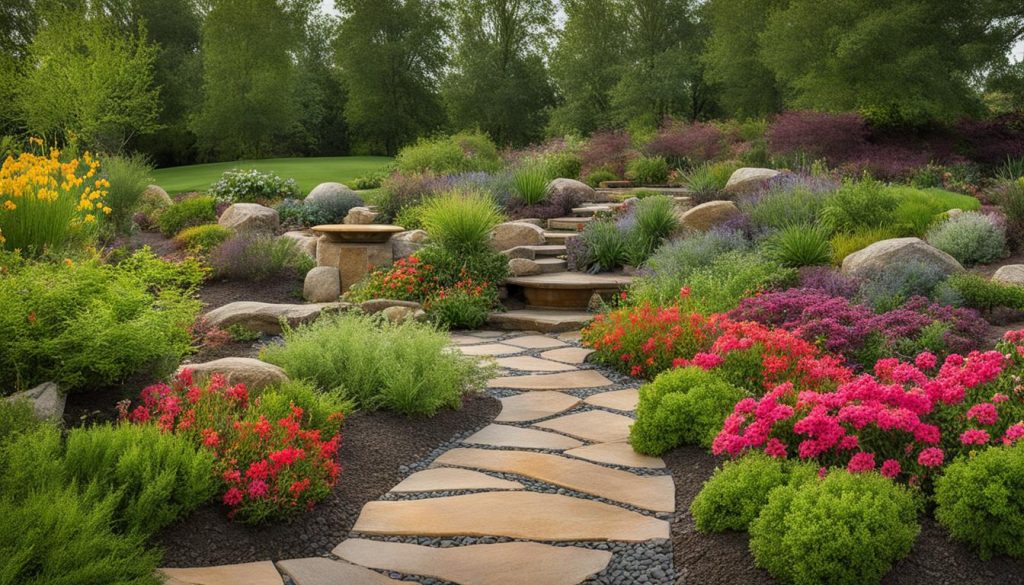
Ultimately, choosing sustainable landscaping practices is an essential step towards creating a healthier and more sustainable outdoor environment. Our choices can have a significant impact on the world around us, and by prioritizing sustainability, we can help ensure a brighter future for generations to come.
Key Elements of Sustainable Landscaping
In sustainable landscaping, we prioritize environmental health, efficiency, and design. Here are some key elements to consider when creating a sustainable outdoor space:
- Use native plants: Native plants are adapted to the local climate, require less water, and provide habitat for wildlife. They also help create a sense of place and promote biodiversity.
- Rainwater harvesting: Collecting and storing rainwater helps reduce the use of potable water and prevents runoff, erosion, and flooding. It can be accomplished by using rain barrels, cisterns, or infiltration systems.
- Soil health: Healthy soil is the foundation of any landscape. We can improve soil health by adding compost, using organic fertilizers, reducing soil compaction, and minimizing soil disturbance.
- Composting: Composting is an excellent way to recycle organic waste, reduce landfill waste, and create nutrient-rich soil. It can be done through various methods, such as backyard composting or vermicomposting.
- Natural pest control: Instead of relying on harmful pesticides that can harm the environment and human health, we can use natural pest control methods, such as companion planting, physical barriers, and biological controls.
By incorporating these key elements into our outdoor spaces, we can create a sustainable and beautiful landscape that benefits both us and the environment.
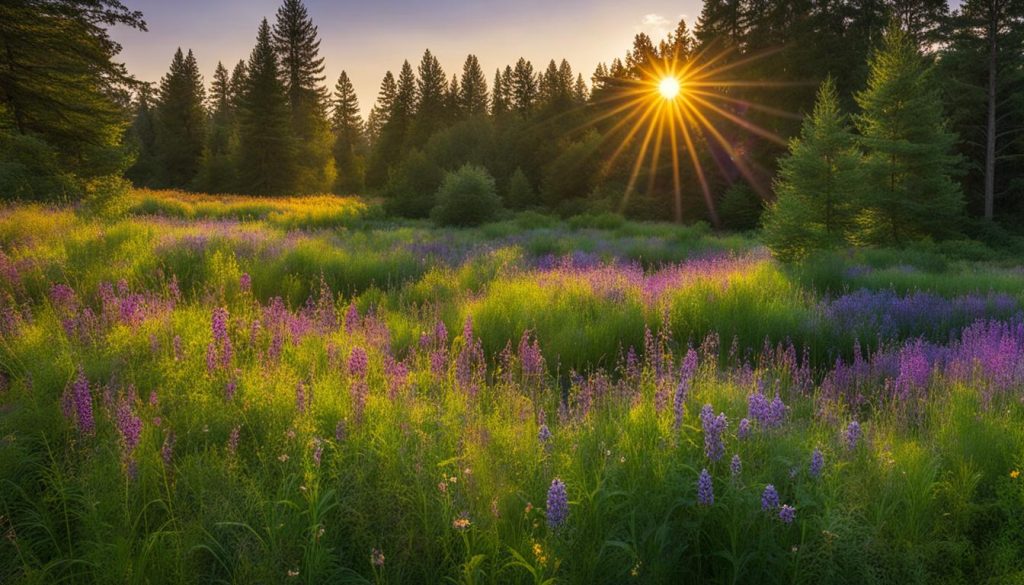
Designing a Sustainable Landscape
Designing a sustainable landscape requires a shift in mindset from traditional landscaping practices. At its core, sustainable landscape design prioritizes environmental responsibility and utilizes eco-friendly features to create a beautiful outdoor space that supports biodiversity and conserves natural resources.
The Principles of Landscape Design
Before embarking on a sustainable landscape design project, it’s important to understand the principles of landscape design that prioritize sustainability. Site analysis is a critical first step in which we evaluate the unique elements of your outdoor space, including soil type, sunlight, and water access, to inform the design. Understanding the natural systems at play in your landscape allows us to create a plan that works harmoniously with the environment.
Another essential principle is utilizing eco-friendly features in the design. This includes selecting materials that are sustainably sourced, such as reclaimed wood or recycled concrete. Efficient irrigation systems, such as drip irrigation, can help reduce water waste. Creating habitats for wildlife, such as native pollinator gardens, adds to the biodiversity of your landscape.
Sustainable Materials
Using sustainable materials is an essential aspect of designing a sustainable landscape. Reclaimed wood is a perfect eco-friendly feature to add to your landscape design. It can be used to create garden boxes, benches and other outdoor furniture. Recycled concrete is another sustainable material that can be used to build retaining walls or hardscaping materials used for walkways and patios.
Another sustainable material that can be used is locally-sourced materials, such as stone or gravel. By sourcing materials from local suppliers, we can reduce the carbon footprint associated with transportation.
Wildlife Habitats
Creating wildlife habitats in your landscape is a fantastic way to promote biodiversity and support pollinators, birds, and other wildlife. By incorporating native plant species, such as milkweed, goldenrod and coneflowers, into your garden, you provide an essential food source and habitat for wildlife. Adding a birdhouse, a small pond, or a pollinator hotel can help create a thriving wildlife haven in your backyard.
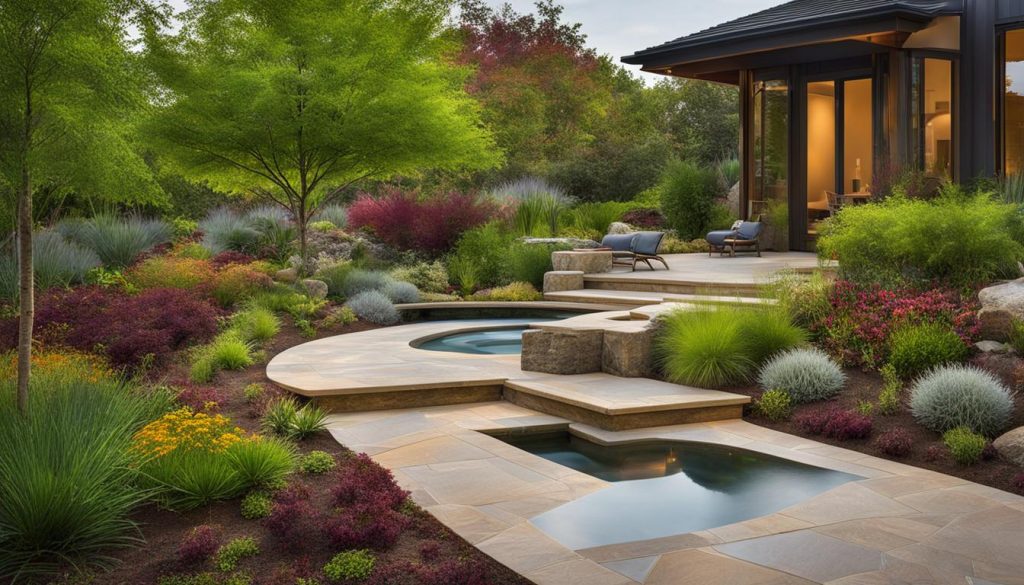
As you can see, creating a sustainable landscape is not only possible but is also a rewarding experience. By prioritizing eco-friendly features such as efficient irrigation, using sustainable materials, and creating habitats for wildlife, you can create a beautiful outdoor space that supports the environment without sacrificing style or function. Join us in designing a sustainable landscape that not only looks good but does good for our planet.
Maintaining a Sustainable Landscape
Maintaining a sustainable landscape requires ongoing effort and attention. Here are some essential maintenance tips to keep your outdoor space looking beautiful while also being eco-friendly.
Choose Organic Fertilizers
Traditional fertilizers can contain harmful chemicals that can leach into the soil and surrounding ecosystems. Instead, opt for organic fertilizers such as compost, manure, or other natural options. These not only provide nutrients to your plants but also improve soil health and promote biodiversity.
Water Wisely
Water is a precious resource, and it’s essential to use it wisely in sustainable landscaping. Avoid overwatering your plants, and consider installing a rainwater harvesting system to collect and reuse water. This not only conserves water but also reduces your water bill.
Practice Responsible Pest Management
Avoid using synthetic pesticides that can harm beneficial insects and pollinators. Instead, opt for natural pest control methods such as companion planting, crop rotation, or using insecticidal soap. This helps maintain a healthy ecosystem in your outdoor space.
Maintain Efficient Irrigation Systems
Check your irrigation system regularly to ensure it’s working correctly and not wasting water. Consider installing a drip irrigation system that targets water directly to the plant’s roots, reducing water loss through evaporation.
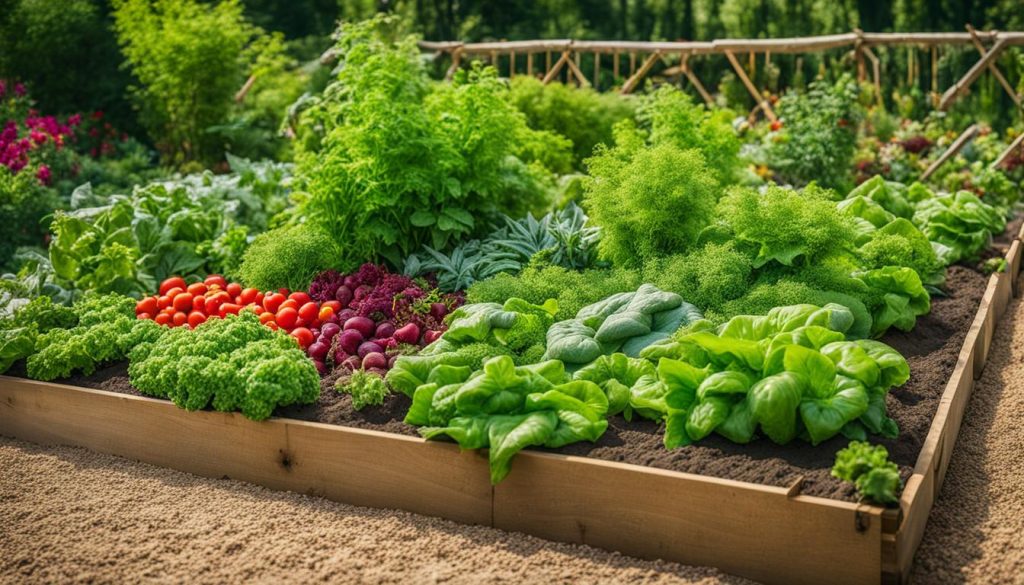
Regular Maintenance
Regular maintenance is crucial to the long-term sustainability of your landscape. This includes pruning, mulching, and removing invasive plants. Proper maintenance helps keep your outdoor space healthy and thriving.
By following these maintenance tips, you can ensure that your sustainable landscape remains healthy and beautiful for years to come.
Embracing Sustainable Living Outdoors
At this point in our journey towards sustainable living, we’ve explored how sustainable landscaping can contribute to a more eco-friendly outdoor space. But sustainable living goes beyond just landscaping and can encompass a wide range of outdoor activities and practices.
Creating Wildlife Habitats
One of the most rewarding ways to embrace sustainable living outdoors is by creating wildlife habitats. Adding features like birdhouses, bird baths, and butterfly gardens can attract a variety of local wildlife to your outdoor space. Not only does it make your space more enjoyable, but it also supports local ecosystems and promotes biodiversity.
Growing Your Own Food
Another great way to embrace sustainable living is by growing your own food. Whether you have a small garden or a larger farm, growing your own food is satisfying and can help you reduce your ecological footprint. Organic gardening practices, such as composting, can help you maintain healthy soil and reduce the need for harmful pesticides.
Composting
Composting is an essential aspect of sustainable living that can reduce waste and transform it into a valuable resource for your garden. By composting your food and yard waste, you can create nutrient-rich soil that can enhance the health and vitality of your plants.
Reducing Waste
In addition to composting, there are many other ways to reduce waste outdoors. By using eco-friendly products like reusable water bottles, cloth napkins, and recycled materials, you can significantly reduce your impact on the environment. Furthermore, by properly disposing of hazardous materials like batteries and electronics, you can prevent them from polluting the environment.
Conclusion
Embracing sustainable living outdoors can be a fulfilling and enriching experience. Whether through sustainable landscaping or eco-friendly outdoor activities and practices, there are many ways to make a positive impact on the environment. By taking small but impactful steps towards sustainability, we can create a better future for ourselves and the planet.
If you have any questions, our team is always happy to help. Contact Landscaping Near Me today!
FAQ
What is sustainable landscaping?
Sustainable landscaping refers to the practice of designing, creating, and maintaining outdoor spaces in an environmentally responsible and resource-efficient manner. It involves using eco-friendly practices, such as conserving water, minimizing waste, promoting biodiversity, and reducing the use of synthetic chemicals.
Why should I choose sustainable landscaping?
Choosing sustainable landscaping is beneficial for both the environment and your outdoor space. It helps reduce water consumption, prevent soil erosion, support local wildlife, and minimize the use of harmful chemicals. Additionally, sustainable landscapes are aesthetically pleasing and can increase the value of your property.
What are the key elements of sustainable landscaping?
The key elements of sustainable landscaping include using native plants, rainwater harvesting, healthy soil practices, composting, natural pest control, and proper irrigation. These elements promote ecological balance, conserve water, and create a resilient and sustainable landscape.
How do I design a sustainable landscape?
Designing a sustainable landscape involves considering factors such as site analysis, incorporating eco-friendly features, utilizing sustainable materials, and creating habitats for wildlife. It is important to prioritize water efficiency, biodiversity, and the long-term sustainability of the outdoor space.
How do I maintain a sustainable landscape?
To maintain a sustainable landscape, you can practice proper watering techniques, use organic fertilizers, implement responsible pest management strategies, and regularly assess the health of your plants and soil. Regular maintenance ensures the longevity and sustainability of your outdoor space.
How does sustainable landscaping contribute to a sustainable lifestyle?
Sustainable landscaping is a part of embracing a sustainable lifestyle as it encourages responsible use of resources, promotes biodiversity, and reduces the environmental impact of outdoor spaces. By incorporating eco-friendly practices in your landscape and embracing outdoor activities like composting and growing your own food, you can further contribute to a sustainable lifestyle.

